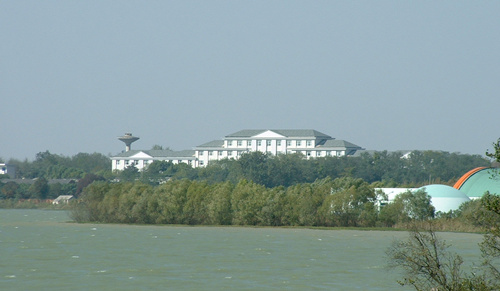
Our Vision
CASHIPS integrates its multidisciplinary expertise and world-class facilities to seek grand science solutions to challenges of world’s scientific and technical frontiers. With our core competence based on national large research infrastructures, we strive to address national demands through the study of magnetic confinement fusion to explore strategic energy; environmental monitoring and pollution control technology for environment challenges; high magnetic field science and technology research to gain deeper understanding of matters and life; and cutting-edge interdisciplinary research to solve the challenges in health, modern agriculture and advanced manufacture.
Research Themes
1、Science and Technology of Magnetic Confinement Fusion
As a kind of acknowledged strategic energy, nuclear fusion is the most ideal energy choice for future development, due to its prominent advantages of abundant resource, clear, safety and et al. To realize the controlled development of nuclear fusion energy and address the strategic needs of energy, CASHIPS carries out research of magnetic confinement fusion science and technology based on EAST (Experimental Advanced Superconducting Tokamak), which focuses on ITER key technology and makes pre-research on CFETR key technology. Moreover, CASHIPS conducts systematical investigations on fundamental science of nuclear reactor; and carries out targeted research and development on nuclear safety to provide strong technical support for safe development of nuclear energy.
1) Plasma physics: key physics of tokamak experiments, such as auxiliary heating and current drive, plasma confinement and transport; key physics of plasma with metal wall and tungsten divertor; exploration of advanced steady operation mode for future reactor.
2) Magnetic confinement engineering technology: key engineering technology to promote the device performance of EAST; investigation on key technology of ITER and pre-research on key technology of CFETR.
3) Neutron Physics: research on lead-based reactor technologies for the disposal of nuclear waste using ADS; neutron physics theory and simulation methodology for advanced nuclear energy systems.
4) Nuclear Energy Safety Technology: effective methods for monitoring and defending of high-energy neutrons; integrated simulation research on nuclear emergency response.
2. Environmental Monitoring and Pollution Control Technology
Environmental security has become one of the most severe challenges in the 21st century for China and even the world. To meet the China’s major strategic needs in environmental field, CASHIPS makes long-term efforts in national condition oriented environmental researches which develop environmental monitoring and pollution control technology to provide strong technical support to ensure environmental security and realize green and sustainable development.
1) Environmental pollution monitoring technology: satellite-borne monitoring technology and overall stereoscopic monitoring technology for atmospheric environment; new methods of regional atmospheric pollution monitoring; automatic in-situ monitoring technology for multi-factor of environment and pollution source emission monitoring technology.
2) Research on environmental pollution mechanism: in-depth theoretic and experimental study about atmospheric pollution through the combination of quantum chemistry model, laboratory simulation and out-field experiment; illustrating photophysics and photochemistry properties of aerosol and uncovering formation and transmission mechanism of regional atmospheric pollution.
3) New technology of pollution control: highly efficient techniques for environmental priority pollutant control and processing, through developing advanced purification technology based on nano materials, exhausting gas treatment technology by low temperature plasma treatment and etc..
3.High Magnetic Field Science and Technology
High magnetic field, as one of extreme conditions for scientific research, has become the most effective method to explore new effects and phenomena, as well as reveal inner structure and intrinsic rules of motion and transformation of matters. Depending on the static high magnetic field facility (SHMFF), CASHIPS carries out multidisciplinary researches of physics, chemistry, material science and bio-science under extreme conditions, which further strengthen the competence of cutting-edge research and promote the development of strategic high technology addressing energy, material and health needs.
1) High magnetic field technology research: developing advanced technology of 50T steady high magnetic field facility, depending on key technology of water cooling magnets and superconducting magnets; new methodologies of synthesis and characterization under high magnetic field.
2) Quantum phenomena and new effect under high magnetic field: synthesis and modification of magnetic materials and low- dimensional functional materials under high magnetic field; quantum transport properties, quantum manipulation, superconductivity physics and new effect of low dimension system; new physical effect under high pressure.
3) Biological properties in extreme environment: regulation mechanism of biological system in response to extreme conditions,e.g.high magnetic field; novel law of the transmission of structure and information as well as energy metabolism within biological system.
4. Cutting-edge Interdisciplinary Research
Addressing world science frontiers and strategic need of national economy, CASHIPS outlines forward-looking plan for development of research directions, for instance, robots and intelligent equipment, advanced materials in extreme environment, modern agricultural technology, medical physics and technology. In addition, CASHIPS conducts cutting-edge interdisciplinary researches to provide technical support for sustainable development of economy and society.
1) Robots and intelligent equipment: developing special sensors, special robots and technologies of intelligent equipment and prompting their transformation.
2) Advanced materials for special usage: developing new functional materials working in special environment, such as strong irradiation, deep space landing, specific polluted environment, and etc.;investigating their physical properties.
3) Modern agricultural technology: radiation mutagenesis and molecular breeding; smart agriculture and green agriculture; large-scale integration and demonstration of developed agricultural technology.
4) Medical physics and technology: new diagnosis techniques on molecular level, novel methods of precise therapy for tumor; application research of physical techniques (i.e. medical laser, mass spectrometry, plasma, etc.) and information techniques into medical science.
 Tel: +86-551-65591206
Tel: +86-551-65591206
 Fax: +86-551-65591270
Fax: +86-551-65591270
 Emai: zhous@hfcas.ac.cn
Emai: zhous@hfcas.ac.cn
 350 Shushanhu Road
350 Shushanhu Road